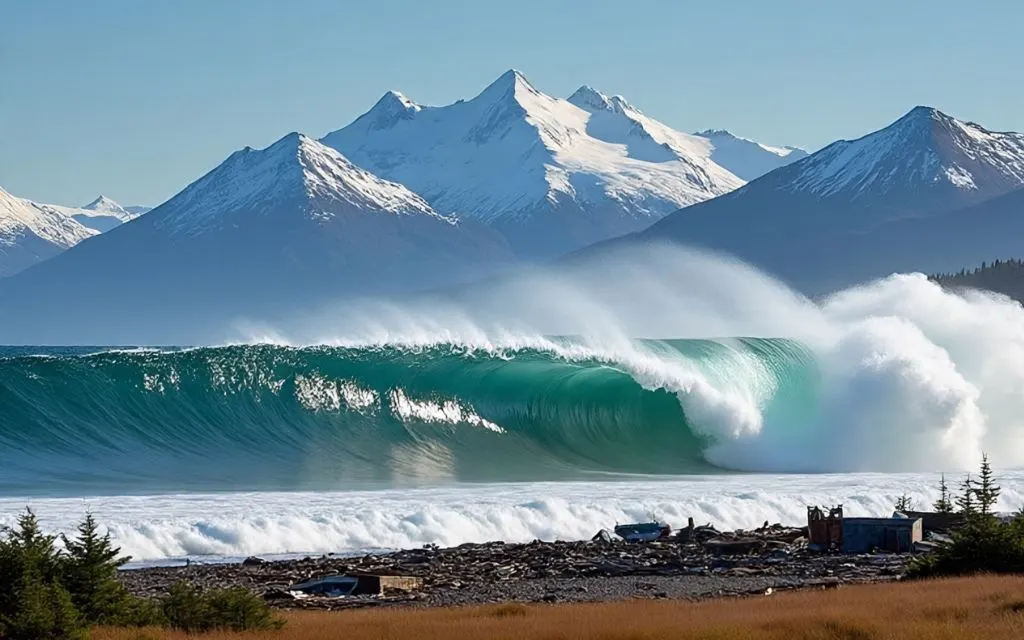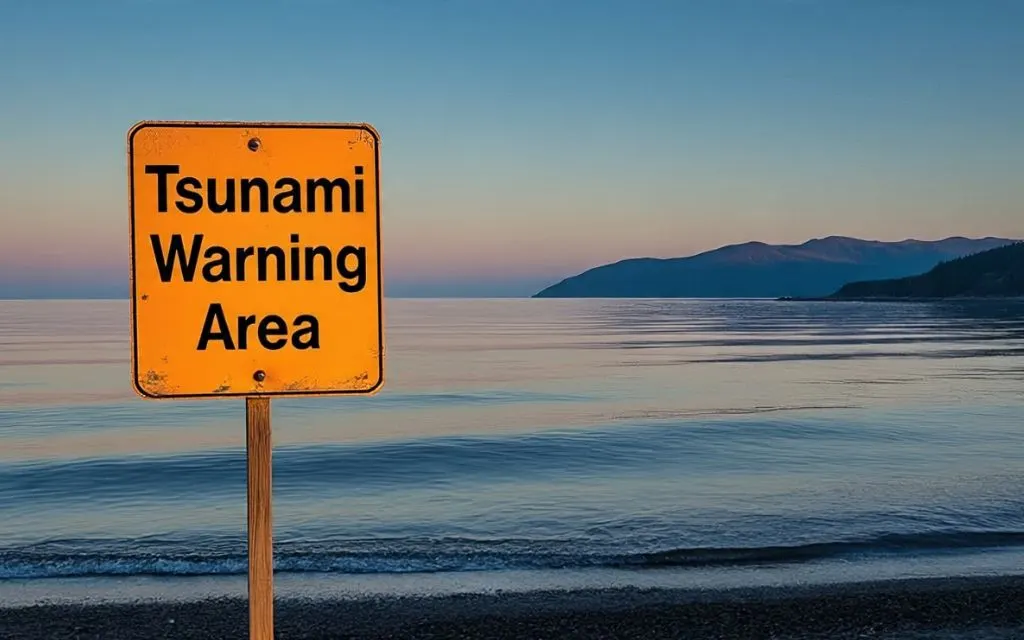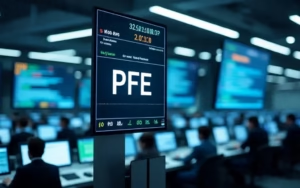The Alaska tsunami is one of the most feared natural disasters in the North Pacific region. Located on the tectonically active Pacific Ring of Fire, Alaska is highly vulnerable to earthquakes and undersea landslides, both of which can trigger devastating tsunamis. Over the years, several tsunamis have impacted Alaska, claiming lives, destroying property, and reshaping coastlines. Understanding the risks and history of the Alaska tsunami is essential for anyone living in or traveling to this region.
Understanding What an Alaska Tsunami Is
A tsunami is not just a single large wave, but a series of powerful waves that result from sudden disturbances beneath or near the ocean. These disturbances can be caused by underwater earthquakes, volcanic eruptions, landslides, or even large glacier collapses — all of which are common geological events in Alaska. When such a disturbance happens on or near the seafloor, it displaces a large volume of water, triggering a ripple effect that spreads rapidly across the ocean.
In the case of an Alaska tsunami, the most frequent cause is seismic activity. Alaska lies along the Pacific Ring of Fire, a region known for intense geological activity, including the collision of tectonic plates. The Pacific Plate and the North American Plate constantly grind against each other, building up pressure deep beneath the Earth’s crust. When this pressure is released suddenly through an earthquake, the ocean floor may shift, pushing massive amounts of water upward. This movement sets off a tsunami that races across the ocean at speeds up to 500 miles per hour.
While the initial wave may not look threatening out in the open ocean, it changes dramatically as it approaches the shore. The seafloor becomes shallower near land, which causes the tsunami waves to slow down but also grow in height and intensity. This is when the danger becomes truly evident. An Alaska tsunami can reach coastal towns within minutes, leaving little time for residents to evacuate.
What makes an Alaska tsunami particularly dangerous is its unpredictability. Sometimes, a large earthquake may not generate a tsunami at all, while a smaller one might trigger massive waves if it occurs close to shore or causes a landslide into the ocean. Additionally, Alaska’s rugged coastline, with its fjords, bays, and inlets, can funnel and amplify tsunami waves, making them more destructive in certain locations.
Historically, Alaska has experienced some of the most powerful tsunamis on record. The 1964 Good Friday Earthquake, which measured 9.2 on the Richter scale, caused a devastating tsunami that struck coastal communities across Southcentral Alaska, killing over 100 people and causing massive damage as far away as California and Hawaii.

Historical Alaska Tsunami Events
Alaska’s rugged beauty and dramatic coastline tell a powerful story of nature’s raw force. Throughout history, the state has experienced several devastating tsunamis that have left a lasting impact on communities, landscapes, and scientific understanding. These Alaska tsunami events not only highlight the region’s vulnerability to seismic activity but also serve as sobering reminders of the power beneath our oceans.
The 1964 Great Alaska Earthquake and Tsunami
Perhaps the most infamous Alaska tsunami event took place on March 27, 1964, following what is now known as the Great Alaska Earthquake. With a staggering magnitude of 9.2, it remains the second most powerful earthquake ever recorded in the world and the strongest in North American history. This massive quake ruptured the seafloor along a 600-mile stretch and lasted nearly five minutes — an eternity in geological terms.
The energy released during the earthquake triggered a series of tsunamis that devastated many coastal towns across southern Alaska. In places like Valdez, Seward, Kodiak, and Whittier, waves as high as 30 to 50 feet came crashing down on docks, homes, canneries, and roads. Whittier saw waves that reached 43 feet, while in Valdez, the tsunami destroyed the entire waterfront, claiming many lives in seconds. The powerful surges even reached as far as Hawaii, California, and parts of Japan, demonstrating the vast reach of an Alaska tsunami.
In total, 131 people lost their lives, including 106 in Alaska, many due to the tsunami rather than the earthquake itself. This tragic event reshaped Alaska’s coastline, led to the relocation of entire communities like Valdez, and changed the way scientists and emergency planners understand and respond to tsunamis.
The 1958 Lituya Bay Mega-Tsunami
Another astonishing but lesser-known Alaska tsunami occurred on July 9, 1958, in Lituya Bay, a narrow fjord on the southeast coast of Alaska. Unlike the 1964 event, this tsunami was triggered not by an earthquake, but by a massive landslide. A 7.8 magnitude earthquake shook the region, dislodging about 90 million tons of rock from a mountainside that plunged into the bay.
The resulting displacement of water caused a wave that surged to a mind-blowing height of 1,720 feet — the tallest tsunami ever recorded in history. The colossal wave stripped trees and soil from the hillsides and completely wiped out everything in its path. Although Lituya Bay is remote and sparsely populated, three fishing boats were anchored in the bay at the time. Two people tragically died, but miraculously, a boat carrying a man and his son rode the wave and survived to tell the tale.
Despite the relatively low human toll, the 1958 Lituya Bay tsunami is a landmark event in geological studies. It stands as a dramatic example of how landslides and seismic activity can produce mega-tsunamis capable of reshaping entire landscapes within seconds. Scientists continue to study Lituya Bay as a case study in extreme tsunami formation.
Other Noteworthy Alaska Tsunamis
While the 1964 and 1958 tsunamis are the most prominent, Alaska has seen several other tsunami events that underscore the ongoing risks along its coastlines. In 2018, a major earthquake near Kodiak Island triggered widespread tsunami warnings, prompting evacuations throughout southern Alaska. Although a large wave did not materialize that time, the event showed just how quickly communities must be ready to respond.
In 2020, a powerful glacial landslide in the Barry Arm fjord region raised alarms for a potential tsunami threat in Prince William Sound. While the anticipated wave did not occur immediately, scientists continue to monitor the area for signs of future collapse, as melting glaciers in Alaska increasingly destabilize slopes above coastal waters.
Causes of Alaska Tsunamis
The formation of an Alaska tsunami is the result of powerful natural events that occur deep beneath the Earth’s surface or in the rugged terrain of Alaska’s coastline. While many people associate tsunamis solely with earthquakes, there are actually multiple causes that can generate the kind of devastating wave activity seen in this region. The unique geology of Alaska — with its shifting tectonic plates, steep coastal slopes, and active volcanoes — makes it one of the most tsunami-prone areas in the world.
1. Earthquakes and the Alaska-Aleutian Subduction Zone
The most common and significant trigger of an Alaska tsunami is an undersea earthquake. Alaska lies at the edge of the Pacific Ring of Fire, where intense geological activity is concentrated. The primary fault responsible for much of this seismic movement is the Alaska-Aleutian subduction zone — a massive tectonic boundary that stretches for over 2,000 miles.
In this subduction zone, the Pacific Plate is slowly being forced beneath the North American Plate, a process known as subduction. As the plates grind against each other, pressure builds up over time. Eventually, this stress is released in the form of an earthquake, often occurring beneath the seafloor. When the seabed is suddenly uplifted or displaced, it pushes enormous volumes of ocean water upward, creating a tsunami that radiates outward from the epicenter.
The 1964 Great Alaska Earthquake is a perfect example of this process. It was caused by a rupture along the subduction zone and generated a massive tsunami that devastated coastal towns and communities. Because of this tectonic setting, Alaska is considered one of the most seismically active regions on the planet, which in turn means it faces constant risk of tsunamis.
2. Submarine Landslides
Another powerful cause of an Alaska tsunami is a submarine landslide — an underwater collapse of sediment and rock. These events can be triggered by earthquakes or occur independently due to unstable slopes along the ocean floor or fjord walls. When a large volume of sediment suddenly shifts underwater, it displaces the surrounding water and creates waves that can quickly evolve into a tsunami.
Submarine landslides are particularly dangerous because they can occur very close to shore, leaving little to no warning time for coastal residents. Alaska’s deep coastal fjords and glacial valleys make it especially susceptible to this kind of event. The steep underwater topography, combined with rapidly melting glaciers, increases the risk of slope failure both below and above sea level.
One notable example of a landslide-generated Alaska tsunami is the 1958 Lituya Bay event. Though technically above water, the massive rockfall into the narrow bay acted similarly to a submarine landslide, displacing water so forcefully that it created a wave over 1,700 feet tall. Modern-day landslide risks — especially those connected to melting permafrost and retreating glaciers — are closely monitored to prevent future disasters.
3. Volcanic Eruptions
While less frequent, volcanic eruptions can also cause an Alaska tsunami, especially if they occur near or beneath the ocean. Alaska is home to more than 130 volcanoes, many of which are still active today. Most are located along the Aleutian Islands, where volcanic activity is both intense and regular due to the same subduction processes that drive earthquakes.
When a volcano erupts explosively, it can cause a sudden displacement of earth and water. For example, if the side of a volcanic mountain collapses into the sea, or if a volcanic island erupts violently, the explosion can push vast amounts of seawater outward, forming a tsunami. Another potential scenario is a phreatomagmatic eruption — when magma comes into contact with seawater, causing a violent steam explosion that can trigger a wave event.
The 1883 Krakatoa eruption in Indonesia is often cited as a global example of this phenomenon, but similar events are possible in the Aleutians, where active volcanoes like Shishaldin, Pavlof, and Cleveland lie close to the ocean. While such events are rare, they remain a real threat, especially as seismic and volcanic activity in Alaska continues
Areas Most at Risk from Alaska Tsunamis
Coastal communities across Alaska are at risk. Towns such as Seward, Valdez, Kodiak, and Homer are particularly vulnerable due to their proximity to subduction zones and undersea fault lines. The Aleutian Islands, stretching far into the Pacific, are also in a prime location for earthquake and tsunami activity.
Although the lower 48 states of the United States are farther away, the impact of an Alaska tsunami can extend far beyond Alaska. For example, the 1964 tsunami affected the coasts of California and Oregon, causing damage and even fatalities.
Modern Warning Systems and Preparedness
Today, Alaska is better prepared than ever before. The National Tsunami Warning Center, located in Palmer, Alaska, monitors seismic activity and issues alerts in real time. When an undersea earthquake occurs, the center analyzes data to determine whether a tsunami is likely and where it might strike.
Sirens, emergency broadcasts, and mobile alerts are used to inform the public of any Alaska tsunami threats. Schools, businesses, and local governments conduct regular drills to ensure everyone knows how to evacuate safely. Maps outlining evacuation routes are widely available, and educational programs help residents understand the risks and how to respond.
The Role of Climate Change and Melting Glaciers
Recent studies suggest that climate change could increase the risk of Alaska tsunamis. As glaciers melt, they can destabilize steep slopes and increase the likelihood of landslides. These landslides, especially if they fall into fjords or coastal waters, could trigger localized tsunamis.
One notable example is Barry Arm, a steep slope overlooking Prince William Sound. Scientists have observed that the retreat of Barry Glacier has made this slope unstable. If it collapses into the water, it could generate a massive Alaska tsunami, potentially impacting nearby communities with little warning.
Economic and Environmental Impact of Alaska Tsunamis
The aftermath of an Alaska tsunami is not just a human tragedy but also an economic and environmental disaster. Infrastructure like roads, ports, and buildings are often destroyed. Fishing industries, which are vital to Alaska’s economy, can be disrupted for months or even years.
Tsunamis can also devastate natural habitats. Estuaries, wetlands, and coastal forests may be flooded with saltwater, killing off vegetation and wildlife. The debris and pollutants carried inland by tsunami waves can contaminate freshwater sources and soil.
Stories of Survival and Heroism
Amid the destruction, the human spirit shines through. In the 1964 Alaska tsunami, many residents risked their lives to save others. Teachers led students to higher ground, and first responders worked around the clock to rescue those trapped in debris. These stories underscore the importance of community, preparedness, and quick thinking.
How to Stay Safe During an Alaska Tsunami
If you are in Alaska and feel a strong earthquake or receive a tsunami warning, take it seriously. Move to higher ground immediately. Do not wait for official instructions if you are in a tsunami-prone area and feel shaking. Tsunamis often strike quickly after an earthquake, and every second counts.
Prepare a tsunami emergency kit that includes water, food, flashlights, batteries, and a first aid kit. Know your local evacuation routes and practice them with your family. Stay informed through local news, NOAA alerts, and community bulletins.
The Future of Alaska Tsunami Research and Safety
Research into Alaska tsunamis continues to improve forecasting and preparedness. Scientists use seafloor sensors, satellite data, and geological surveys to better understand tsunami risks. New models are being developed to predict wave height, arrival times, and impact zones more accurately.
Public awareness campaigns are helping to educate people about the dangers of the Alaska tsunami. School programs, community seminars, and online resources aim to ensure that everyone, from children to seniors, understands what to do in the event of a tsunami.
Conclusion
The Alaska tsunami is a powerful reminder of nature’s unpredictability. Though we cannot prevent earthquakes or undersea landslides, we can prepare for them. With modern technology, public awareness, and community cooperation, the risks can be minimized.
Anyone living in or visiting Alaska should take the threat of a tsunami seriously. Stay informed, be prepared, and understand the history and science behind these waves. The more we know about the Alaska tsunami, the better equipped we are to survive it and protect our communities.




